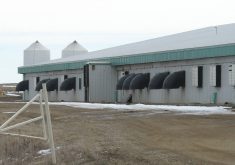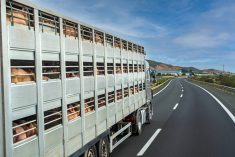A new law to track Canada’s pigs took effect July 1.
It’s designed to keep herds healthy, improve food safety and promote exports, Manitoba Pork Council chair Karl Kynoch said in a telephone broadcast June 25.
“Traceability has become mandatory and is extremely important for both tracking diseases here in Manitoba and to eliminate them fast and also for exports,” Kynoch said. “Manitoba exports 85 per cent of the product and our buyers today are asking for traceability, traceback and food safety.”
Under the new “PigTrace” program, almost all premises-to-premises swine movements have to be reported, except barns within the same premises.
Read Also

Seeding Indigenous agricultural prosperity
National Circle for Indigenous Agriculture and Food says Indigenous agricultural success needs strong relationships.
Depending on the type of animals and premises involved, movement reporting may or may not require individual animal identification.
- More from the Manitoba Co-operator: And this little piggy goes to…? New traceability program on the way
Jeff Clark, manager of the Canadian Pork Council’s PigTrace program provided the following details during the broadcast:
Animal identification requirements
Farm-to-farm movement for anything other than sows and boars does not require any form of identification. However, farmers can identify their animals during moves to other farmers.
A sow or boar moving to a farm needs to have an approved tag with a number, which is reported to PigTrace when the animal is moved.
ID for animals going to slaughter
Market hogs, lightweight pigs, barbecue hogs and suckling pigs need either a shoulder slap tattoo with the owner’s herd mark number (the hog owner’s five-digit number specific to a location assigned by the Manitoba Pork Council) or an approved ear tag supplied only by PigTrace.
There are two types of ear tags. One is the herd mark. The farmer’s own herd management number can be printed on the lower portion of the tag for the farmer’s use.
The other is an individual identification tag with a 15-digit number unique to each animal.
Cull sows and boars going to slaughter
Cull sows and boars require a shoulder slap tattoo or approved ear tag.
The market is moving to ear tags because many slaughter plants skin the animals removing the slap tattoo.
Farmers are encouraged to switch to ear tags as they replace animals in their herds.
Tags cost 68 cents. Electronic tags are $2.16 and work with sow-feeding systems.
Exports of weanlings and feeder pigs
The Canadian Food Inspection Agency (CFIA) is phasing out its numbering system. It’s being replaced by the hog owner’s herd mark applied as a slap tattoo.
An ear tattoo can also be used.
Farmers can add the birth week letter to the tag but it’s not required for export.
Farmers can get a herd mark quickly from the Manitoba Pork Council.
PigTrace also sells small ear tags that say “export” on them for 40 cents each.
Other exports — breeding stock
Exports of breeding stock require a herd mark tag or individual ear tag.
Export slaughter hogs
The United States doesn’t require imported Canadian hogs destined for slaughter to be identified with a tag. However, if there’s any chance that hogs destined for export will end up staying in Canada, they require a slap tattoo.
Movement-reporting requirement
In all cases PigTrace is a dual-entry system with both shipper and receiver required to report information about the movement of swine. This is necessary because not every animal is getting an individual ear tag — something hog producers viewed as onerous.
Movement reports to PigTrace require the shipper’s location, number of swine being moved, their destination, date and time they departed and when they arrived at destination. The licence number of the trailers hauling the animals must also be submitted.
Shippers are also encouraged to provide the licence number of the truck-tractor if the animals move via semi.
Any animal ID on the pigs needs to be reported too.
Other movements
When sows and boars are moved from farm to farm, to a fairground or to a farm via an assembly yard they must be individually ear tagged with a 15-digit number starting with 124, which is Canada’s country code. The other 12 digits are unique to each animal.
Swine moved in this way are seen as higher risk because of reduced biosecurity.
These tags must come from PigTrace.
Imports
Any imported swine must get an individual identification ear tag upon arrival in Canada.
Deadstock
When moving deadstock from a farm, owners must report the farm’s location and the company or individual picking it up and the date.
“Anything slaughtered or consumed or composted on farm does not need to be reported, (and) doesn’t need ear tags,” Clark said. “It doesn’t fall under this program at all.”
Hog farmers can call Manitoba Pork for more information about PigTrace or visit its website.
Temporary usernames and passwords have been mailed to Manitoba hog farmers. First they should activate their PigTrace accounts.
Farmers can report pig movements online using a computer or mobile device.
Farmers who wish to report swine movement via a spreadsheet, fax or over the telephone should contact the Manitoba Pork Council at 888-893-7447 or PigTrace 866-300-1825.
















